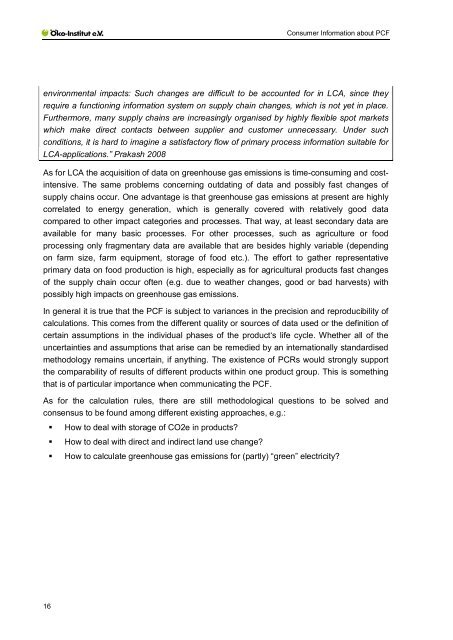Requirements on Consumer Information about Product ... - ANEC
Requirements on Consumer Information about Product ... - ANEC
Requirements on Consumer Information about Product ... - ANEC
Create successful ePaper yourself
Turn your PDF publications into a flip-book with our unique Google optimized e-Paper software.
C<strong>on</strong>sumer Informati<strong>on</strong> <strong>about</strong> PCF<br />
envir<strong>on</strong>mental impacts: Such changes are difficult to be accounted for in LCA, since they<br />
require a functi<strong>on</strong>ing informati<strong>on</strong> system <strong>on</strong> supply chain changes, which is not yet in place.<br />
Furthermore, many supply chains are increasingly organised by highly flexible spot markets<br />
which make direct c<strong>on</strong>tacts between supplier and customer unnecessary. Under such<br />
c<strong>on</strong>diti<strong>on</strong>s, it is hard to imagine a satisfactory flow of primary process informati<strong>on</strong> suitable for<br />
LCA-applicati<strong>on</strong>s.” Prakash 2008<br />
As for LCA the acquisiti<strong>on</strong> of data <strong>on</strong> greenhouse gas emissi<strong>on</strong>s is time-c<strong>on</strong>suming and costintensive.<br />
The same problems c<strong>on</strong>cerning outdating of data and possibly fast changes of<br />
supply chains occur. One advantage is that greenhouse gas emissi<strong>on</strong>s at present are highly<br />
correlated to energy generati<strong>on</strong>, which is generally covered with relatively good data<br />
compared to other impact categories and processes. That way, at least sec<strong>on</strong>dary data are<br />
available for many basic processes. For other processes, such as agriculture or food<br />
processing <strong>on</strong>ly fragmentary data are available that are besides highly variable (depending<br />
<strong>on</strong> farm size, farm equipment, storage of food etc.). The effort to gather representative<br />
primary data <strong>on</strong> food producti<strong>on</strong> is high, especially as for agricultural products fast changes<br />
of the supply chain occur often (e.g. due to weather changes, good or bad harvests) with<br />
possibly high impacts <strong>on</strong> greenhouse gas emissi<strong>on</strong>s.<br />
In general it is true that the PCF is subject to variances in the precisi<strong>on</strong> and reproducibility of<br />
calculati<strong>on</strong>s. This comes from the different quality or sources of data used or the definiti<strong>on</strong> of<br />
certain assumpti<strong>on</strong>s in the individual phases of the product‘s life cycle. Whether all of the<br />
uncertainties and assumpti<strong>on</strong>s that arise can be remedied by an internati<strong>on</strong>ally standardised<br />
methodology remains uncertain, if anything. The existence of PCRs would str<strong>on</strong>gly support<br />
the comparability of results of different products within <strong>on</strong>e product group. This is something<br />
that is of particular importance when communicating the PCF.<br />
As for the calculati<strong>on</strong> rules, there are still methodological questi<strong>on</strong>s to be solved and<br />
c<strong>on</strong>sensus to be found am<strong>on</strong>g different existing approaches, e.g.:<br />
• How to deal with storage of CO2e in products?<br />
• How to deal with direct and indirect land use change?<br />
• How to calculate greenhouse gas emissi<strong>on</strong>s for (partly) “green” electricity?<br />
16
















